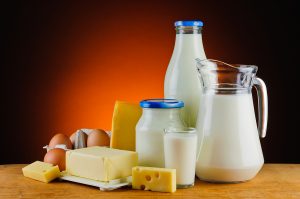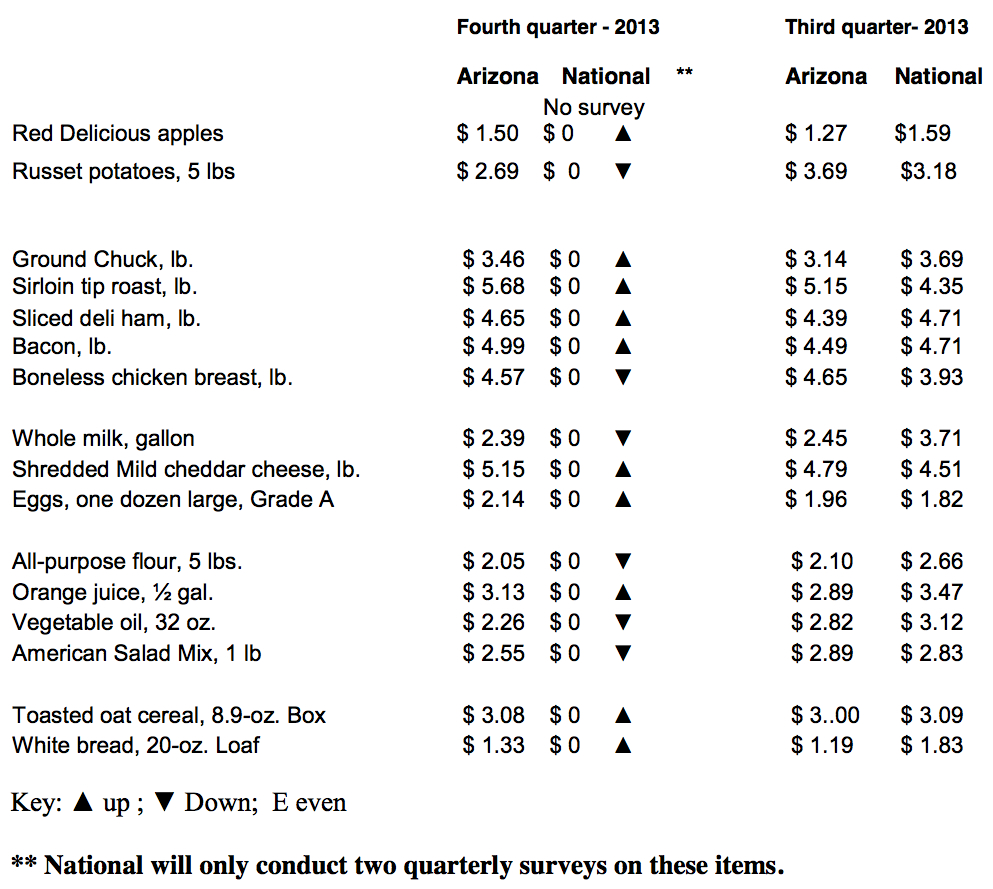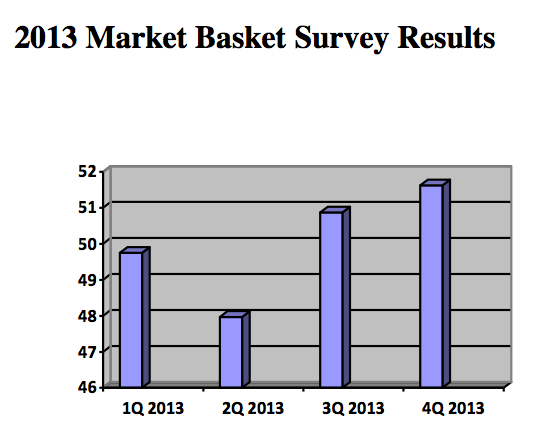
The 4th Quarter food prices are out! See the report to know if the prices of milk, eggs, and cheese are rising or falling. (photo credit: BigStockPhoto.com)
Arizona retail food prices at the supermarket are up in the fourth quarter of 2013, according to the latest Arizona Farm Bureau Federation Marketbasket Survey. The informal survey shows the total cost of 16 basic grocery items was $51.62, up $.75 cents or about 1.5% more than the third quarter of 2013.
Compared to this time last year, the 2013 fourth quarter Marketbasket survey shows that Arizona’s food prices have increased about 2 percent.
“While we’re in the new year looking back at last quarter’s food prices we’re getting a pretty good gauge of what prices will do in 2014,” said Arizona Farm Bureau’s Communication Director, Julie Murphree. “We continue to encourage Arizona families to keep hunting for those bargains in our basics like your meats, fruits, vegetables, diary and eggs to stretch your food dollars.”
Of the 16 items surveyed in Arizona, six decreased and ten increased compared to the 2013 third quarter survey.
“Last week, meatpackers paid the highest cash prices on record for live, market-ready cattle,” added Murphree. “The meat industry is grappled with tight cattle supplies due in part to drought in parts of the U.S. Great Plains. Plus, consumer demand for meat has been high. As a result, analysts suggest the higher cattle prices likely will be passed along to you and me in the next few months. We’ll report if this took hold when we release our First quarter 2014 marketbasket prices in the coming months.”
In Arizona, off-the-shelf prices for potatoes showed the greatest decrease in price down $1.00 to $2.69 a 5-pound bag; vegetable oil down 56 cents to $2.26 a 32 ounce bottle; salad mix down 34 cents to $2.55 a pound bag; boneless chicken breast down 8 cents to $4.57 a pound; milk down 6 cents to $2.39 a gallon; and flour down 5 cents to $2.05 a 5-pound bag.
“Remember Arizona Farm Bureau’s Fillyouplate.org has searchable recipes, many featuring recipes from our generational Arizona farm families,” said Murphree. “Eating at home as a family can help you manage your food budget better.”
Sirloin roast showed the largest price increase up 53 cents to $5.68 a pound. The other items that increased in price were bacon up 50 cents to $4.99 a pound; shredded cheese up 36 cents to $5.15 a pound bag; ground beef up 32cents to $3.46 a pound: sliced deli ham up 26 cents to $4.65 a pound; orange juice up 24 cents to $3.13 a
half gallon; apples up 23 cents to $1.50 a pound; eggs up 18 cents to $2.14 a dozen; white bread up 14 cents to $1.33 for the 20 ounce loaf and oat cereal up 8 cents to $3.08 for the 8.9 ounce box.
The year-to-year direction of the Marketbasket survey tracks with the federal government’s Consumer Price Index report for food at home.
“In the mid-1970s, farmers received about one-third of consumer retail food expenditures for food eaten at home and away from home, on average. That figure has decreased steadily and is now just 16 percent, according to the United States Department of Agriculture’s revised Food Dollar Series Department statistics,” explains John Anderson, American Farm Bureau Economist. The USDA’s new Food Dollar Series may be found online.
Using the “food at home and away from home” percentage across-the-board, the Arizona farmer’s share of this quarter’s $51.62 Marketbasket total would be $8.25.
The Farm Bureau Market Basket Survey is unscientific, but serves as a gauge of actual price trends across the state. Arizona’s bargain shoppers statewide should find individual items at prices comparable to the Farm Bureau survey averages and certainly cheaper with discounts and in-store specials. Arizona Farm Bureau seeks to identify the best in-store price, excluding promotional coupons and special deals.
Arizona Farm Bureau’s 18 Money Saving Tips to Stretch Your Food Dollars:
- Sort your pantry and organize to clearly know what’s available. This should be a regular effort in order to make sure you’re using everything you have, not buying unnecessary items and can determine what you really need.
- Create a week-long menu. From the planned menu create your shopping list based on local grocery store circulars you receive in the mail or newspaper.
- When planning your menu, think of ways to maximize the use of the “Stretch Your Food Dollar” menu as a springboard to create your own menu. Gather ideas for meals based on the items down in price from Arizona Farm Bureau’s “Stretch Your Dollar” menus on fillyourplate.org. Let the Farm Bureau’s menus inspire your creativity!
- You’ve created the list; stick to it. If you can stick to your list, you’ll curb impulse spending on items you don’t really need.
- Don’t shop on an empty stomach. Studies suggest you might spend 10 to 15 percent more on your food bill when you’re hungry.
- Don’t take the kids grocery shopping. As with an empty stomach, kids can influence your impulse shopping.
- Stick to the basics. While basic food items like dairy, meat, fruits and vegetables can sometimes seem expensive, you’re gaining more value per unit and certainly more health benefits. The fewer processed food items you purchase, the more you’ll save.
- Regularly survey the weekly grocery store circulars. This will build your knowledge of prices for products you regularly use and give you a sense of which grocery stores tend to have the lowest prices. Take advantage of weekly advertised specials, especially for nonperishable staples.
- Be wary of the coupon trap. Use coupons only for those items you normally buy. Don’t let coupons cost you money by buying items you don’t really need. A sale has no value to you if it means you’re spending beyond your budget. Do take advantage of “ad-matching” since lots of savings can be found here.
- Assess the unit price. This shopping tool lets you compare prices between brands and between sizes. Located on a shelf tag in front of the product, it provides costs in like units for the item. Generally, information is given in cost per ounce, per pound or per count.
- Shop the edges of the store, and if items at the ends of the aisles reflect a super deal buy. As aisle-end items are dramatically marked down, they might be a valuable substitute on your grocery list. But they’re budget busters if they become purchased food items you don’t use in your food preparation.
- Use grocery store club cards; also compare prices to store brands. Store club cards can generate great savings. Plus, while you might love a certain brand, also compare a popular brand to the store brand for price comparisons and possible savings.
- Peak season is prime time to buy fresh produce. The peak of the harvest for fresh fruits and vegetables offers you the best prices and the best quality. Take advantage of this and buy often. To always know what’s in season, go to fillyourplate.org and select the tab “Arizona Produce in Season.”
- When not buying fresh, consider buying frozen. Most frozen vegetables are picked fresh, immediately flash frozen, are less expensive and will keep longer.
- Buy in bulk, but don’t buy more than you will use. Bigger is not always better. Larger-sized packages usually cost less on a per-unit basis. But it’s not a better buy if it’s too large to use before it becomes stale or spoiled.
- Move in on “family pack” savings. Meat departments often have a section that offers larger- sized packages at cents-off-per-pound savings. Repackage these larger sizes into smaller quantities at home and freeze.
- Be flexible at the meat and produce counters. This is one area to be flexible with your list. This allows you to take advantage of unadvertised “in store” specials and switch from one item to another.
- Use open dating codes, especially on perishables to maximize shelf life at home. Open dating is used on perishable and semi-perishable products to let you know at a glance if the product is fresh. Most stores use a “pull date” – the last day the item is offered for sale. This still allows a few days for using at home. For stores that use a “pack date,” especially with meats, inquire how long the product will remain fresh at home.
The importance of improving farm practices is not lost on Arizona Farm Bureau members. “To feed the majority of Americans, crop and livestock agriculture must continually become more efficient, and in many cases, larger to spread energy and labor costs across more acres to help stabilize prices at the grocery store,” said John Boelts, vegetable farmer from Yuma, Arizona. Boelts, who said the cost for just one refueling of one large tillage tractor can be more than $600, explained that labor and energy are the two largest farm operating costs that must be controlled
Related articles
- Arizona Agriculture: The Promise of Food Prices; They Will Change (azfb.org)
- Marketbasket: Classic Arizona Thanksgiving Dinner Cost increases Slightly in 2013 (fillyourplate.org)
- Arizona Food Prices are Up 6% in the Third Quarter of 2013 (fillyourplate.org)



